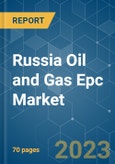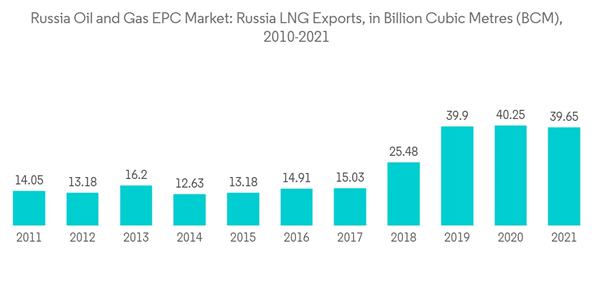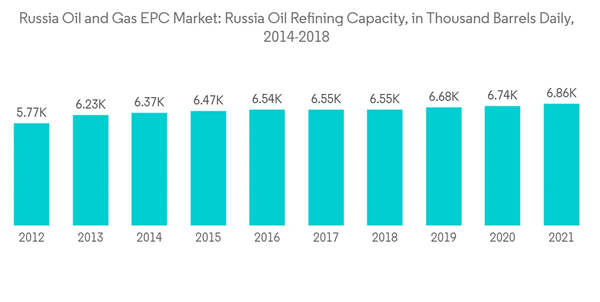Russia Oil and Gas EPC Market is projected to register a CAGR of over 1.5% during the forecast period.
COVID-19 negatively impacted the market in 2020. Presently the market is likely to reach pre-pandemic levels.
This product will be delivered within 2 business days.
COVID-19 negatively impacted the market in 2020. Presently the market is likely to reach pre-pandemic levels.
Key Highlights
- Over the medium term, factors such as IMO regulation and global efforts to reduce the use of coal for power generation, the demand for natural gas and low-sulfur fuel are expected to increase. This factor, in turn, is expected to promulgate the increasing EPC contracts across the midstream and the downstream sectors.
- On the other hand, the United States sanctions and restrictions on collaboration with Russia are likely to restrain the country's oil and gas EPC market.
- Nevertheless, the shift of the E&P sector toward offshore deep and ultradeep areas is expected to be the major opportunity for the Russian Oil and Gas EPC Market. Russia has been actively producing oil and gas from the Arctic shelf for quite some time. Still, with a decline in onshore hydrocarbon production, the national oil companies have no choice but to shift to complex and technologically challenging offshore deep-water and ultradeep water fields.
Russia Oil & Gas EPC Market Trends
Midstream Segment to Dominate the Market
- Oil and gas pipelines, storage, and LNG and RLNG facilities are the major midstream infrastructures that require EPC services. The growing oil and gas production, export, and aging pipeline infrastructure drive the demand for new midstream infrastructure.
- The EU imported approximately 155 billion cubic meters (bcm) of Russian natural gas in 2021. This figure is estimated to rise, owing to factors like an increase in the demand for energy in Europe and the subsequent increase of the pipeline network by Russia.
- The country witnessed an increase in its LNG exports in the past few years, with a growth of about 168.08% from 14.79 billion cubic meters in 2010 to 39.65 billion cubic meters in 2021. The country currently has two LNG plants, Gazprom-led Sakhalin-2 on the Far East, Novatek’s Yamal LNG on the Arctic Yamal peninsula, Gazprom's Portovaya LNG and Novatek's Kriogas-Vysotsk LNG.
- Further, Russia has historically exported most of its natural gas through pipelines to Europe and China. As of Q2 2022, it is developing LNG liquefaction plants as the Russian government's strategy to diversify gas exports to European and Asian markets without major investments in pipeline infrastructure. As of April 2022, Russia had 136.7 MTPA of liquefaction capacity proposed. In Eastern Russia, Far East LNG, also named Sakhalin-1 LNG (6.2 MTPA), is a major project in the pre-FID pipeline. Therefore, once these projects are realized, the CAPEX in the oil and gas industry is expected to increase over the forecast period., which, in turn, is expected to lead to growth in the EPC market.
- In September 2021, RusKhimAlyans, Linde, and Renaissance Heavy Industries signed an EPC contract to build a natural gas liquefaction plant within the Gas Processing Complex near Ust-Luga (GPC, part of the Complex for processing ethane-containing gas; the GPC operator is RusKhimAlyans, a joint venture of Gazprom and RusGazDobycha). The contract was signed in St. Petersburg, Russia. According to the EPC contract, the consortium of Linde and Renaissance Heavy Industries is likely to provide equipment and materials for design works, as well as to perform the construction and installation of two production trains with a total capacity of 13 million tpy of LNG. Moreover, a technology patented (patent holders: Gazprom & Linde) in Russia is likely to be used to produce this LNG. Therefore, such contracts and technological developments will positively impact the Russian midstream segment during the forecast period.
- Hence, the aforementioned factors are expected to contribute to the market's growth during the forecast period.
Increasing Investments in Petrochemical Industry to Drive the Market
- In the latest world energy outlook, BP forecasted that the global crude oil and condensate demand may rise by less than 3 million barrels per day between 2019 and 2040 due to the increasing growth rate in the use of electric vehicles, among other factors. Hence, like other hydrocarbon-focused economies, Russia is also looking to push into petrochemical amid uncertain global crude oil demand prospects.
- Moscow, Russia's capital city, is also planning to take new measures to spur the petrochemical industry development, with a target of doubling production to around 20 million metric tons per year by 2030.
- The Russian oil refineries produced approximately 6.9 million barrels per day in 2021, an increase over the previous year. Between 2011 and 2021, the daily refinery capacity across the country increased by approximately 1.2 million barrels.
- As of March 2022, there were 44 active refineries in the country, with a combined capacity of about 7 million barrels per day. Most of the oil refineries in the country were commissioned in the Soviet Era and before that. Refinery utilization in the country has remained low for quite some time and has started increasing since 2019.
- Most of the demand of the Russian EPC market in the downstream sector is expected to come from the petrochemicals sector. In January 2022, DL E&C (a Korean company specializing in EPC) won a contract to build a mega-scale gas chemical plant in Russia, defeating advanced European countries. The project aims to construct the world’s largest polymer plant on a single-line basis in the region of Ust-Luga, 110 kilometers southwest of St. Petersburg, Russia. The value of the contract is about USD 1.20 billion, and DL E&C will take charge of design and equipment procurement. Once completed, the plant can produce 3 million tons of polyethylene, 120,000 tons of butane, and 50,000 tons of hexane a year.
- Also, in February 2022, Samsung Engineering (one of the world’s leading EPC and project management companies) signed a EUR 1 billion contract with China National Chemical Engineering & Construction Corporation Seven Ltd for the design and procurement work of the Baltic Ethane Cracker Project in Russia. Baltic Chemical Complex LLC (CC7), the original contract owner, previously signed an EPC contract with CC7 in 2019. The project is located at the Gulf of Finland near the seaport of Ust-Luga, Leningrad Oblast, 110 km southwest of St. Petersburg, Russia. Samsung’s scope of work includes an Ethane Cracker Unit (core process element of the plant) with a total design capacity of 2.8 million T/y (Ethylene 1.4 million t/y * 2 Trains) and procurement for the project.
- Hence, the increasing petrochemical infrastructure is expected to drive the Russian oil and gas EPC market during the forecast period.
Russia Oil & Gas EPC Market Competitor Analysis
The Russian Oil and Gas EPC Market is fragmented. Some of the key players (not in particular order) in this market include Technip FMC, Hyundai Heavy Industries Co. Ltd, Saipem SpA, Petrofac Limited, and McDermott International Inc., among others.Additional benefits of purchasing the report:
- The market estimate (ME) sheet in Excel format
- 3 months of analyst support
This product will be delivered within 2 business days.
Table of Contents
1 INTRODUCTION
4 MARKET OVERVIEW
5 MARKET SEGMENTATION
6 COMPETITIVE LANDSCAPE
Companies Mentioned (Partial List)
A selection of companies mentioned in this report includes, but is not limited to:
- Saipem SpA
- McDermott International Inc.
- TechnipFMC PLC
- Petrofac Limited
- Hyundai Heavy Industries Co. Ltd
- Assystem SA
- VELESSTROY
- Daelim Industrial Co., Ltd.
- Renaissance Heavy Industries
- Linde plc
Methodology

LOADING...










